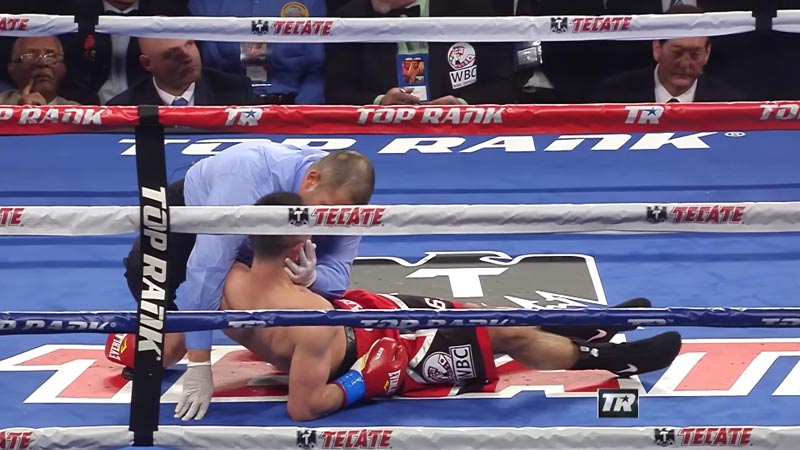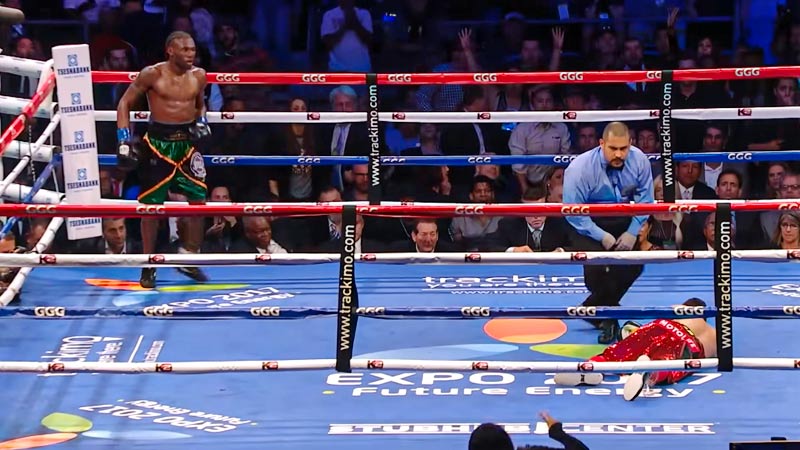Boxing, often referred to as “the sweet science,” is a sport of strategy, power, and skill. At the heart of every thrilling bout is the dramatic moment when a fighter is knocked down.
But what exactly does a knockdown mean in the world of boxing?
In this comprehensive guide, we’ll explore the nuances of knockdowns, their significance in scoring, and the rules that govern these pivotal moments inside the ring.
A knockdown in boxing represents more than just a fighter hitting the canvas; it’s a critical juncture that can change the course of a match.
Understanding the distinctions between types of knockdowns and the rules surrounding them is essential for both fighters and fans of the sport.
Whether you’re a seasoned boxing enthusiast or a newcomer to the ring, this exploration of knockdowns will deepen your appreciation of this high-stakes combat sport.
What Is a Knockdown in Boxing?
In the case of boxing, you should learn exactly what counts as a knockdown in boxing.
In boxing, a “knockdown” refers to a situation in which one fighter is knocked to the canvas or the floor by a punch or a series of punches from their opponent.
A knockdown is a significant moment in a boxing match, as it often results in the referee initiating a count to determine if the downed fighter can continue competing.
Here are the key points to understand about a knockdown in boxing:
Knockdown Rule

When a boxer is knocked down, the referee starts counting to ten. If the downed fighter is unable to stand up and continue boxing before the referee counts to ten, they lose the match by knockout (KO).
If the fighter successfully rises before the count of ten, the match continues.
Three Knockdown Rule
Some boxing organizations, such as the World Boxing Association (WBA), have implemented a “three knockdown rule.”
If a fighter is knocked down three times in a single round, they are considered knocked out, and the match is stopped.
Knockdown vs. Knockout
A knockdown is different from a knockout. In a knockout (KO), a boxer is unable to get up within the referee’s count of ten and is declared the loser.
In a knockdown, the fighter has the opportunity to recover and continue fighting.
Knockdown Scoring
Knockdowns can have a significant impact on the scoring of a round. In many cases, a 10-8 round is scored when one fighter scores a knockdown.
If a fighter scores multiple knockdowns in a single round, it can be scored as 10-7, indicating a dominant round.
Flash Knockdown
Sometimes, a fighter may be momentarily stunned or off balance, causing them to briefly touch the canvas. This is known as a “flash knockdown.”
Referees may choose not to count this as a knockdown if they determine that the fighter was not genuinely hurt.
It’s important to note that boxing rules and regulations can vary by organization and jurisdiction, so there may be slight differences in how knockdowns are handled in different bouts.
Nevertheless, the concept of a knockdown and the referee’s count are consistent features of professional and amateur boxing matches.
How to Score a Boxing Knockdown?
Scoring a knockdown in a boxing match is relatively straightforward, as it involves following specific rules and criteria set by the officials.
To properly score a knockdown, you should consider the following factors:
Legal Knockdown

A legal knockdown occurs when a fighter is knocked down to the canvas or the floor due to a punch or a series of punches from their opponent.
For a knockdown to be considered legal, the punches must land cleanly on the opponent, and the fighter must go down as a result.
Referee’s Count
When a fighter is knocked down, the referee will start counting. The referee’s count usually begins with “One,” and they continue counting up to “Ten.”
The downed fighter has until the count of “Ten” to get up and demonstrate that they are able to continue fighting.
Clear Knockdown
A knockdown is scored when a fighter touches the canvas with any part of their body other than their feet, due to the force of a punch.
If a fighter slips, is pushed or falls without a direct and forceful punch causing it, it should not be scored as a knockdown.
Knockdown Duration
The referee will assess the downed fighter’s condition while counting.
If the fighter cannot get up and remain on their feet by the count of “Ten,” the bout is considered a knockout, and the fighter who scored the knockdown is declared the winner.
Flash Knockdown
In some cases, a fighter may briefly touch the canvas but recover immediately without any loss of balance or consciousness.
If the referee determines that the fighter was not genuinely hurt and it was merely a momentary loss of balance, it may not be scored as a knockdown.
Scorecard Implication
A knockdown can have a significant impact on the scoring of a round. In most cases, a 10-8 round is awarded to the fighter who scored the knockdown.
If a fighter scores multiple knockdowns in a single round, it can be scored as 10-7, indicating a dominant round.
Scoring a knockdown is a critical aspect of boxing, and it can change the outcome of a fight.
Judges and the referee play a crucial role in ensuring that knockdowns are scored accurately and fairly according to the established rules and regulations of the boxing organization overseeing the match.
Types of Knockdowns in Boxing

In boxing, knockdowns can occur in various ways, and they are typically categorized into different types based on how they occur and the specific circumstances.
Here are some common types of knockdowns in boxing:
Clean Knockdown
This is the most common type of knockdown in which a fighter is cleanly and decisively struck by their opponent and is knocked to the canvas as a result.
Clean knockdowns typically involve a well-placed and powerful punch, such as a hook, uppercut, or cross, that lands on the opponent’s chin, jaw, or body.
Flash Knockdown
A flash knockdown occurs when a fighter is momentarily off-balance or stunned but quickly recovers and gets back on their feet. This type of knockdown is often the result of a glancing blow or a punch that doesn’t fully connect.
Referees may choose not to count flash knockdowns, as they are not indicative of significant damage or an inability to continue.
Accidental Knockdown
Sometimes, a fighter may go down due to an accidental collision or entanglement with their opponent. This is not a result of a punch but rather a consequence of physical contact, and it is not scored as a knockdown.
Push Knockdown
A push knockdown happens when a fighter is pushed or shoved to the canvas by their opponent, intentionally or unintentionally. These are not scored as knockdowns because they do not result from a clean punch.
Technical Knockdown
A technical knockdown can occur when a fighter’s glove, knee, or any other part of their body touches the canvas. It may be ruled as a knockdown even if the fighter is not seriously hurt.
Referees may issue a standing eight-count in some cases, allowing the fighter to continue after the count.
Rope Knockdown
If a fighter is hurt and is held up by the ropes, with no ability to defend themselves, the referee may intervene and count it as a knockdown.
The fighter must then prove they can continue before the referee allows the fight to continue.
Three-Knockdown Rule
Some boxing organizations implement a “three-knockdown rule,” where if a fighter is knocked down three times in a single round, they are considered knocked out, and the match is stopped.
It’s important to note that the exact rules and interpretations of knockdowns may vary depending on the specific boxing organization and the jurisdiction where the match is taking place.
Referees play a critical role in determining whether a knockdown is valid and when to initiate the count. In any case, knockdowns significantly influence the scoring and outcome of a boxing match.
Does a KO count as a knockdown in Boxing?

Yes, a knockout (KO) is a type of knockdown in boxing. When a boxer scores a knockout, it is a definitive and significant type of knockdown.
In a knockout, one fighter lands a punch or a series of punches that incapacitate their opponent to the point where they cannot get up within the referee’s count of ten.
As a result, the match is stopped, and the fighter who scored the knockout is declared the winner.
A knockout represents the most decisive form of a knockdown, as the downed fighter is unable to continue the bout.
In terms of scoring, a knockout is typically recorded as a 10-8 round in favor of the fighter who achieved the knockout.
It can be a single punch or a combination of punches that lead to a knockout, and it often results in a dramatic and conclusive end to a boxing match.
Tips to Survive a Knockdown in Boxing
Surviving a knockdown in boxing is crucial for a fighter’s chances of winning the match.
While the best way to avoid being knocked down is through good defensive skills, it’s also important to know how to react when you find yourself on the canvas.
Here are some tips to help you survive a knockdown in boxing:
Stay Calm
The first and most important thing is to remain composed. Take deep breaths and stay focused. Panic can hinder your ability to recover.
Listen to the Referee
Pay attention to the referee’s count and instructions. The referee’s count typically starts at “One” when you’re down. Stay down until the referee counts to “Nine” before attempting to get up.
Use the Count
Take full advantage of the referee’s count to regain your composure and energy. Use the count of ten to recover and assess your condition.
Protect Yourself
While you’re on the canvas and during the count, protect your head and body with your gloves. This minimizes the risk of taking additional punches if your opponent approaches you.
Control Your Breathing
Deep, controlled breathing can help you recover faster. Inhale through your nose and exhale through your mouth. This can help you regain your composure and clear your head.
Visualize
While down, visualize yourself getting back up and resuming the fight. Positive mental imagery can be powerful for maintaining focus and determination.
Get Up Carefully
When the referee’s count reaches nine, use your hands and knees to rise. Take your time to stand up. Make sure you’re steady on your feet before attempting to continue.
Clinch and Hold
Once you’re back on your feet, consider clinching your opponent to tie them up and limit their ability to land more punches. This can buy you some time to recover and regain your bearings.
Move and Jab
If you’re not hurt too badly, try to move around the ring and use your jab to keep your opponent at bay. This can help you regain control of the fight.
Defense
Focus on your defensive skills to avoid taking additional damage. Keep your guard up and look for opportunities to counter your opponent’s punches.
Listen to Your Corner
If you have a coach or corner personnel, listen to their instructions between rounds. They can provide valuable advice and assess your condition.
It’s important to remember that the ability to survive a knockdown often comes down to conditioning, mental toughness, and the preparation you put into your training.
Developing solid defensive skills, improving your overall fitness, and practicing recovery techniques can all contribute to your ability to survive a knockdown and potentially turn the fight in your favor.
FAQs
Does a knockout count as a knockdown in boxing?
No, a knockout does not count as a knockdown in boxing. A knockout occurs when a fighter is unable to continue the match due to being rendered unconscious or defenseless.
A knockdown is when a fighter is momentarily floored by a legal blow but can still continue after a referee’s count.
Does a TKO Count as a Knockdown Boxing?
A TKO (Technical Knockout) also does not count as a knockdown in boxing. A TKO is when a fighter cannot continue due to injuries or is deemed unable to defend themselves, and the referee stops the fight for their safety.
This is different from a knockdown, which is a brief floor but not necessarily a fight stoppage.
What’s considered a knockdown in boxing?
In boxing, a knockdown is when a fighter is hit with a legal punch and touches the canvas with any part of their body other than their feet.
The referee then begins a count, and if the fighter rises before the count reaches ten and appears able to continue, the match goes on.
Does a knockout count as a knockdown?
No, a knockout does not count as a knockdown in boxing. A knockout signifies a definitive victory, as one fighter is rendered unconscious or incapable of defending themselves.
In contrast, a knockdown is a temporary event in which a fighter is floored but still capable of resuming the fight after the count.
What is a knockdown in boxing?
A knockdown in boxing occurs when a fighter is momentarily floored by a legal punch and makes contact with the canvas, excluding their feet.
The referee initiates a count, typically to ten, and if the downed fighter rises before that count ends and demonstrates readiness to continue, the fight proceeds.
Wrapping Up
In the fast-paced and intense world of boxing, a knockdown is a game-changing moment that can shape the outcome of a match.
It’s not merely about a fighter hitting the canvas; it’s about the drama, the strategy, and the resilience that define the sport.
We’ve delved into the depths of this pivotal aspect of boxing, examining the rules, the types of knockdowns, and their scoring implications.
With the knowledge gained in this guide, you can now appreciate the intricate dance of skill and strategy that unfolds in the ring. A knockdown is not just a test of physical strength but also a test of mental fortitude, determination, and the will to continue.
Whether you’re an aspiring boxer, a seasoned fan, or just someone intrigued by the sweet science, understanding what a knockdown truly means is a vital piece of the boxing puzzle.







